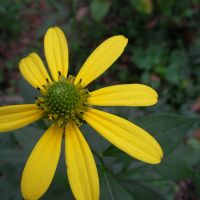Summertime here in northern Nagano is very pleasant, quite unlike the muggy ovens of the big cities. This year, after living here for 32 years, I was persuaded to install a fan. We certainly don't have a cooler. At night, or while working in my study, I leave the windows open to let in the sounds of the rushing Torii River and a refreshing mountain breeze. Moreover, even on the hottest days, a cold shower here is cold, not lukewarm, and the water straight from the tap is cool and delicious.
But then, of course, we have horseflies or deerflies, big and small. Some of them are striped black and yellow and are as big as hornets; these take a chunk out of you when they bite and it hurts, and even more annoying is that their saliva, which they drool onto the wound to stop it from clotting and to enable them to start slurping, can raise great red swellings. I haven't forgotten the mosquitoes and those tiny little blackflies. Therefore we country residents don't go around in T-shirts and shorts.
Another thing to contend with is the rapid growth of plants, which is fine for cucumbers, tomatoes, bell peppers, eggplants and blueberries, but a real problem for the stuff we don't usually eat and would prefer not to have changing our vegetable patches into jungles.
When I first came to live here we had a lovely meadow next door, with the lovely trilling of rising larks and the sweet fragrance of cut hay. However, our neighbor imports his cattle feed now and doesn't bother with the hay, so the meadow turns into an impenetrable 3-meter-high thicket of invasive pigweed. I have to fight back this green wall at the bottom of our garden, otherwise it will take over.
Last year we got a directive from the Ministry of the Environment about another invasive plant, and were informed that if this plant was allowed to spread in our woodland trust, we could be fined. The plant in question is called ōhan-gon sō in Japanese, and if you've been out in the country at all you've probably seen it. In English it has many names, including cutleaf, coneflower, goldenglow, thimbleweed and herbstonne; the scientific name is Rudbeckia laciniata. It is a member of the aster, daisy and sunflower family. It grows to as much as 3 meters in height and has pretty yellow flowers. This plant originates in the eastern United States and was apparently used by the Cherokee people as a potherb. In the States, many types of this plant are grown in gardens.
When I first saw the flowers I was quite pleased, because they are attractive, and several species of butterflies and moths seemed to like them. Now we know that they have been designated as a pest in Japan, and we certainly know how much they spread, so we had to do something about it. This spring, when the cutleaf plants were still young, we had seven to nine people pulling them from morning to evening, for two days. The plants were gathered in bags and incinerated.
We heard that there were folks in Hokkaido who had tried the young shoots as tempura, and that it was good. That's when I started looking the plants up on the Internet and found that Cherokee and other Native Americans used them as potherbs. It will probably be impossible to get rid of them all, so next year I intend to cook some of the young plants the same way we prepare spinach, i.e., as hitashi. You get a pot of slightly salted, rapidly boiling water and then drop the leaves in. When the water comes back to the boil you remove the plant, wash it in cold running water, squeeze out the excess liquid, then cut for easy eating. Sprinkle with dried bonito and a little soy sauce, or add butter if you prefer.
Cutleaf is certainly spreading throughout Japan. Recently, while visiting Higashimatsushima, Miyagi Prefecture (where we are helping the community to relocate and rebuild a school and where I have been asked by the town to give environmental advice), I was looking over the wide areas of flat land that had been swept clear of houses by the tsunami, and found that the cutleaf flowers were in full bloom, the plants 2 to 3 meters high. Apparently this plant is mildly tolerant to salt, which would in part explain its great success here. We'll just have to let it grow for the time being, there's too much else to do, but it might be a good idea to cut it down, take it to one spot and burn it. It might just take some of the sea salt out of the soil.
Nature certainly fills in voids and will try out all kinds of combinations. In Higashimatsushima, about 80 hectares of former farmland is still under water. The land sunk during the earthquake and tsunami on March 11, 2011, and the sea reclaimed its territory. I say this because this area was originally brackish wetland, turned into paddy fields. Now the deeper parts are as much as 5 meters under water, and the tide flows in and out.
The government talks of building huge dykes, pumping out the salt water and refilling with soil to change it back to rice paddies. I have a better idea. During the several times I have visited I have noted the geese, gulls, cormorants, herons, ducks, ospreys and other water birds coming in numbers. More recently I have seen how oysters have started to cover the submerged and tidally exposed concrete. On Aug. 20 and 21 we saw literally millions of young mullet gathering where water was being pumped from one side of an existing dyke-road to the other. I have never seen such a swarm of fish in Japan except at fish farms during feed time.
Therefore, I saw that the area is better suited to wetland, for birds, juvenile fish and shellfish, and eventually for tourists.
However, that is something else I have to get more involved with. What with battling invasive plants and trying to persuade people to keep their scenery and wildlife and to build a school out of stone and wood instead of levelling the hills, filling the valleys and building the usual ferroconcrete box, I am quite busy.
Mind you, I'm not too busy at lunchtime for a nicely cooled cucumber with some miso paste and a cold beer. Summertime, as the song goes, and the living is easy.




















With your current subscription plan you can comment on stories. However, before writing your first comment, please create a display name in the Profile section of your subscriber account page.